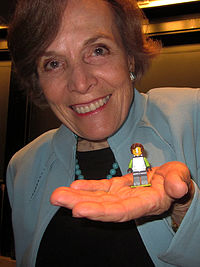SUSAN PRITCHARD, Ph.D.

CONTACT ME
Click here for Science on the Web
Sylvia Alice Earle (born August 30, 1935 in Gibbstown, New Jersey) is an American marine biologist, explorer, author, and lecturer. Since 1998 she has been a National Geographic explorer-in-residence. Earle was the first female chief scientist of the U.S. National Oceanic and Atmospheric Administration, and was named by Time Magazine as its first Hero for the Planet in 1998.
Earle was the Curator of Phycology at the California Academy of Sciences (1979–1986) and a research associate at the University of California, Berkeley (1969–1981), Radcliffe Institute Scholar (1967–1969) and research fellow or associate at Harvard University (1967–1981).
After receiving her Ph.D. in 1966, Earle spent a year as a research fellow at Harvard, then returned to Florida as the resident director of the Cape Haze Marine Laboratory. In 1969, she applied to join the Tektite Project, an installation fifty feet below the surface of the sea off the coast of the Virgin Islands that allowed scientists to live submersed in their area of study for up to several weeks. Although she had logged more than one-thousand research hours underwater, Earle was rejected from the program. The next year, she was selected to lead the first all-female team of aquanauts in Tektite II.

In 1979, she made an open-ocean JIM suit dive to the sea floor near Oahu, setting a women's depth record of 381 metres (1,250 ft). In 1979 she also began her tenure as the Curator of Phycology at the California Academy of Sciences, where she served until 1986.
From 1980 to 1984 she served on the National Advisory Committee on Oceans and Atmosphere.
In 1982 she and her husband, Graham Hawkes, an engineer and submersible designer, founded Deep Ocean Engineering to design, operate, support and consult on piloted and robotic subsea systems. In 1985, the Deep Ocean Engineering team designed and built the Deep Rover research submarine, which operates down to 1,000 metres (3,300 ft). By 1986, Deep Rover had been tested, and Earle joined the team conducting training off Lee Stocking Island in the Bahamas.
She left the company in 1990 to accept an appointment as a chief scientist at the National Oceanic and Atmospheric Administration, where she stayed until 1992. She was the first woman to hold that position. In 1992 she founded Deep Ocean Exploration and Research (DOER Marine) to further advance marine engineering. The company, now run by her daughter, Elizabeth, designs, builds and operates equipment for deep-ocean environments.
Since 1998 she has been a National Geographic explorer-in-residence, sometimes called "Her Deepness or "The Sturgeon General".
From 1998 to 2002 she led the Sustainable Seas Expeditions, a five-year program to study the United States National Marine Sanctuary sponsored by the National Geographic Society and funded by the Goldman Foundation. She was a leader of the Sustainable Seas Expeditions, council chair for the Harte Research Institute for the Gulf of Mexico Studies at Texas A&M-Corpus Christi, and chair of the Advisory Council for the Ocean in Google Earth. She also provided the DeepWorker 2000 submersible used to quantify the species of fish as well as the space resources utilized within the Stellwagen Bank National Marine Sanctuary.
Earle has written children's books, including Coral Reefs, Hello Fish, Sea Critters and Dive!
Earle has founded three companies, among them DOER Marine (Deep Ocean Exploration and Research) in Alameda, California. In 2009, Earle won a TED Prize. With TED's support, she launched Mission Blue, which aims to establish marine protected areas (dubbed "hope spots") around the globe.